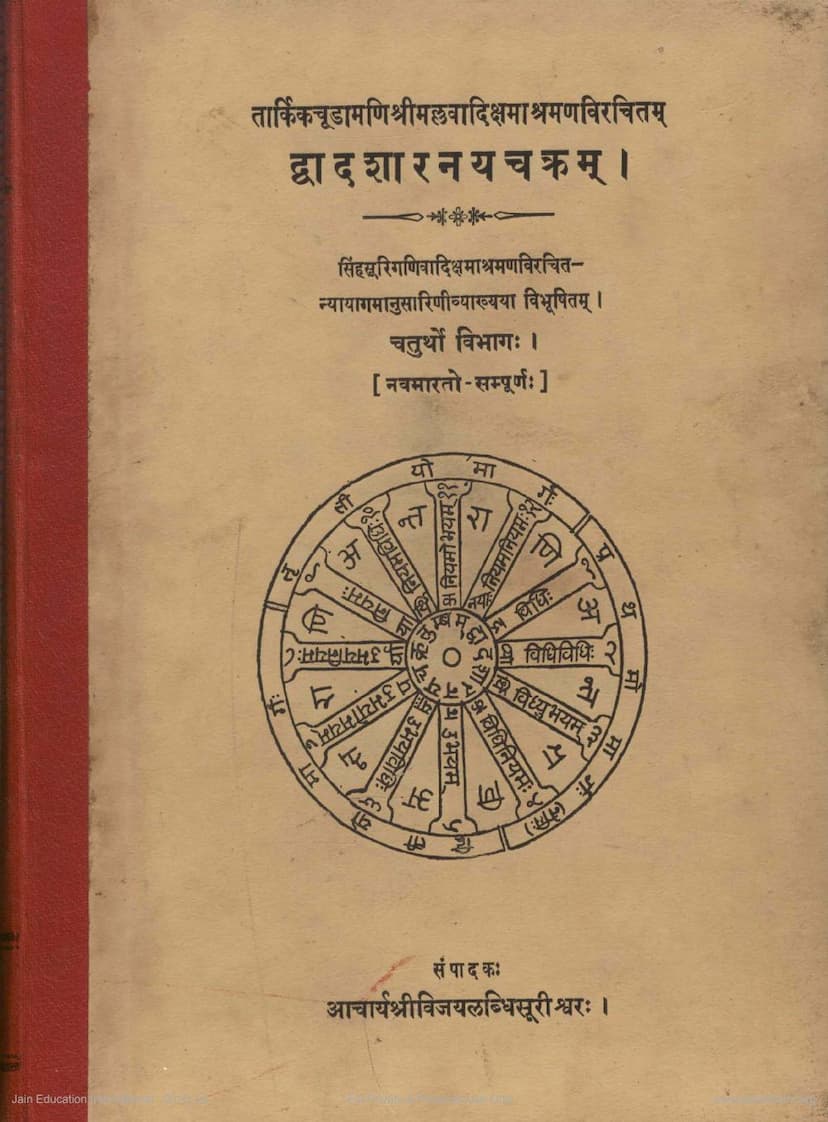Dvadasharnaychakram Part 4
Added to library: September 1, 2025

Summary
Here is a comprehensive summary of the Jain text "Dvadasharnaychakram Part 4," based on the provided pages and foreword:
Dvadasharnaychakram Part 4: A Summary
This volume, the fourth part of the Dvadasharnaychakram, is a significant work by the esteemed Jain scholar Mallavadi Kshamashraman, further enriched by the commentary Nyayagamanusarini by Simhasuriganivadi Kshamashraman. Edited and compiled by Acharya Vijay Labdhi Surishwar, this edition is published by Chandulal Jamnadas Shah under the Shri Labdhisurishwar Jain Granthamala.
Core Themes and Significance:
The Dvadasharnaychakram is a profound treatise on Nayavada (theory of standpoints) and Syadvada (the doctrine of non-absolutism) within Jain philosophy. It aims to establish the truth and comprehensiveness of the Jain perspective by meticulously analyzing and synthesizing various philosophical viewpoints. The text is lauded for its analytical rigor, the breadth of its philosophical engagement, and its ability to reconcile seemingly contradictory ideas through the lens of Syadvada.
Key Concepts Explored:
-
Syadvada and Anekantavada: The foreword by Acharya Vijay Labdhi Surishwar emphasizes the unique strength of Jainism in its Syadvada, which embraces multiple perspectives without clinging to absolutism. This doctrine is presented as the foundation for understanding reality, which is inherently multifaceted (anekanta). The text argues that Syadvada is essential for world peace and justice, capable of harmonizing diverse viewpoints.
-
Naya and Durnaya: The text delves into the concept of Naya (standpoint), explaining its derivation and its crucial role in understanding the infinite attributes of a substance from different angles. It distinguishes between a valid naya, which presents a particular aspect of a substance without ignoring others, and a durnaya, which distorts reality by focusing on one aspect to the exclusion of others.
-
The Twelve Spokes (Aras) of the Wheel: The title Dvadasaranyachakram (Wheel of Twelve Spokes) is explained as a fitting metaphor for the text's structure and content. The twelve spokes represent twelve key nayas or standpoints, organized into three main divisions (Nemis). This cyclical structure, akin to the wheel of time in Jainism, reflects the ceaseless nature of philosophical debate and the author's comprehensive approach. The nayachakra is likened to a Chakra-ratna (wheel-jewel) of emperors, signifying its supreme power in conquering philosophical adversaries.
-
The Nave of Syadvada: Syadvada is presented as the central nave of this wheel, holding together all the spokes (nayas) and providing the ultimate synthesis. Without Syadvada, individual nayas, being inherently one-sided, would lead to conflict. Syadvada's ability to integrate these diverse viewpoints makes it the "Lord of all nayavadas" and the source of universal reconciliation and peace.
-
Philosophical Discourse and Authorship: The foreword extensively discusses the historical context, authorship, and influences on the Dvadasharnaychakram. It references various ancient Jain and non-Jain philosophical traditions and scholars, including:
- Ancient Jain Authors: Siddhasena Divakara, Jinabhadra Gani Kshamashraman, Haribhadra Suri, Malayagiri, and others.
- Non-Jain Philosophies: Buddhism (Nagarjuna, Vasubandhu, Dinnaga), Sankhya (Pancasikha, Varsaganya, Isvarakrishna), Vaisheshika (Kanada, Prashastapada, Ravana), and Vedanta.
- Grammarians: Panini, Katyayana (Vararuci), Patanjali, Vamana, Jayaditya.
- Medical Texts: Charaka Samhita, Susruta Samhita.
- Other Influences: References to the Upanishads, Mahabharata, and Vedic texts.
-
Methodology: The text employs a rigorous dialectical method, presenting opposing viewpoints (purvapaksha) and then refuting them through logical reasoning and scriptural evidence (uttarapaksha). It emphasizes the importance of understanding each standpoint within its specific context (relative truth) before integrating it into the broader framework of Syadvada (ultimate truth).
-
The Commentary and Editorial Efforts: The present edition is highlighted for its critical introduction, detailed index, and the Vishamapadavivechana (explanation of difficult words) by Acharya Vijay Labdhi Surishwar. This meticulous editorial work is crucial for making the complex text accessible to scholars and students of Jain logic. The commentary by Simhasuriganivadi Kshamashraman is recognized for its depth of scholarship, its ability to clarify intricate philosophical arguments, and its adherence to Jain principles.
Structure of the Work (as implied by the Table of Contents):
The detailed index (Anukramanika) suggests a systematic exploration of various nayas, likely structured around the twelve spokes of the chakram. The summaries of each naya in the index indicate discussions on concepts like:
- Niyamnaya: Covering rules and regulations in philosophical arguments.
- Abhijalp: The nature of speech and its relationship to reality.
- Nirvichara-avaktavyata: The ineffable nature of ultimate reality.
- Nihsvabhavata: The doctrine of emptiness or lack of inherent existence (Buddhist influence).
- Anutpada-vinasha: The concepts of origination and cessation.
- Sahaj-Nirvichara: Discussion on spontaneous existence and non-existence.
- Ananta: The concept of infinity.
- Sakala-Nirguna: The nature of the absolute and the formless.
- Sambandha: The concept of relationship between entities.
- Parinaya: Transformation and causality.
- Shunya-vada: The Buddhist doctrine of emptiness.
Overall Contribution:
The Dvadasharnaychakram Part 4 represents a monumental effort in preserving and illuminating a cornerstone of Jain logic. It showcases the intellectual prowess of its authors and the dedicated efforts of its editor, offering invaluable insights into the sophisticated philosophical framework of Jainism. The text serves as a vital resource for understanding the depth and dynamism of Jain thought, particularly its approach to epistemological and ontological questions through the nuanced application of Nayavada and Syadvada.